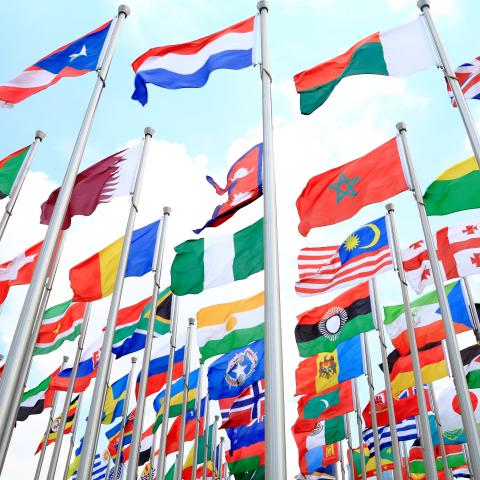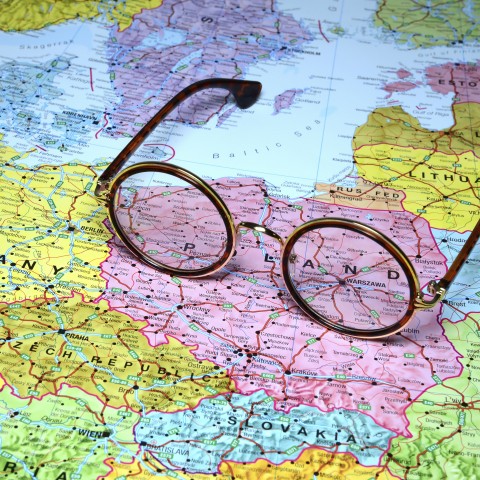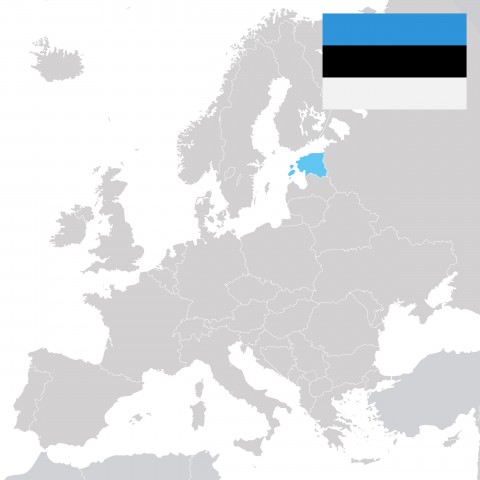
Are you planning to spend time traveling, studying or working in Finland? Maybe a Finnish citizenship is in your sights? Then it’s likely that you will talk about your background sooner or later. Even if you’re just interacting with Finns (or other Finnish learners!) online, the topic may well come up, so it’s not a bad idea to be prepared and learn how to talk about countries and their nationalities in Finnish.
In this article we’ll walk you through some basic grammar rules, teach you useful questions and answers about countries and nationalities, and take a look at who the top expats and foreign visitors in Finland are. Read on to find out if your home country is on the list!

Paljon lippuja (“A lot of flags”)
 Table of Contents
Table of Contents
- Nationalities: A Quick Look at Grammar
- Top Nationalities in Finland
- Talking About Nationality
- Country, City, Nationality & Language
- Lopuksi
1. Nationalities: A Quick Look at Grammar
Before we learn how to say ‘What is your nationality?’ in Finnish, let’s see how we can derive the word for a nationality from the name of a country. In short, simply take the name of a country and add the ending –lainen or –läinen. To choose the correct ending, you need to apply the vowel harmony rule. As you can see in the following examples, the –lainen ending is used when the country name contains back vowels (a, o, u), while the –läinen ending is used when it contains front vowels (y, ä, ö) or only neutral vowels (e, i). Note that while the names of countries are capitalized in Finnish, nationalities are not!
- Japani (“Japan”)
- japanilainen (“Japanese”)
- Egypti (“Egypt”)
- egyptiläinen (“Egyptian”)
- Belize (”Belize”)
- belizeläinen (”Belizean”)
If the country name ends in a consonant, add i before the nationality ending. For example:
- Wales (“Wales”)
- walesilainen (“Welsh”)
Although most nationalities are straightforward to form, there are a few exceptions to the rule, including:
- Venäjä (“Russia”)
- venäläinen (“Russian”)
- Ruotsi (“Sweden”)
- ruotsalainen (“Swedish”)
- Suomi (“Finland”)
- suomalainen (“Finnish”)
By the way, you can also use the –lainen or –läinen ending to refer to someone from a specific region or city! For example:
- eurooppalainen (“European”)
- afrikkalainen (“African”)
- helsinkiläinen (”Helsinkian”)
- pariisilainen (”Parisian”)
- brooklyniläinen (“Brooklynian”)

Puola on eurooppalainen maa. (”Poland is a European country.”)
2. Top Nationalities in Finland
Quick Finnish immigration statistics: According to 2020 figures from Statistics Finland, 8% of the permanent residents in Finland are of foreign background. The proportion of expats is greatest in the 30 to 34 age group, in which every seventh person living in Finland is of foreign background.
The top 10 expat nations in Finland at the end of 2020 were:
| Rank | Country | Nationality |
| 1. | Viro (“Estonia”) | virolainen (“Estonian”) |
| 2. | Venäjä (“Russia”) | venäläinen (“Russian”) |
| 3. | Irak (“Iraq”) | irakilainen (“Iraqi”) |
| 4. | Kiina (“China”) | kiinalainen (“Chinese”) |
| 5. | Ruotsi (“Sweden”) | ruotsalainen (“Swedish”) |
| 6. | Thaimaa (“Thailand”) | thaimaalainen (“Thai”) |
| 7. | Intia (“India”) | intialainen (“Indian”) |
| 8. | Afganistan (“Afghanistan”) | afganistanilainen (“Afghan”) |
| 9. | Syyria (“Syria”) | syyrialainen (“Syrian”) |
| 10. | Vietnam (“Vietnam”) | vietnamilainen (“Vietnamese”) |
What about travelers? According to Statista, the top 10 foreign visitors in Finland in the first half of 2021 were from these countries:
| Rank | Country | Nationality |
| 1. | Saksa (“Germany”) | saksalainen (“German”) |
| 2. | Ruotsi (“Sweden”) | ruotsalainen (“Swedish”) |
| 3. | Viro (“Estonia”) | virolainen (“Estonian”) |
| 4. | Yhdysvallat (“United States”) Amerikka (”America” informal) | yhdysvaltalainen(“citizen of USA”) amerikkalainen (”American”) |
| 5. | Alankomaat (“Netherlands”) Hollanti (“Holland”, informal) | alankomaalainen (“Dutch”) hollantilainen (“Dutch”) |
| 6. | Ranska (“France”) | ranskalainen (“French”) |
| 7. | Norja (“Norway”) | norjalainen (“Norwegian”) |
| 8. | Yhdistynyt kuningaskunta (”United Kingdom”) Iso-Britannia ja Pohjois-Irlanti (”Great Britain and Northern Ireland”) Englanti (“England”) | brittiläinen (“British”) englantilainen (“English”, “Englishman”) |
| 9. | Sveitsi (“Switzerland”) | sveitsiläinen (“Swiss”) |
| 10. | Italia (“Italy”) | italialainen (“Italian”) |

Many Estonians visit and live in Finland.
- Learn the names of many more countries in Finnish on the World Countries vocabulary list on FinnishPod101.
3. Talking About Nationality
It’s time to mingle and get to know people! The first part of this section shows you several ways you can ask other people about their nationality in Finnish. In the second part, you’ll learn different ways to talk about your nationality.
1- How to Ask Someone Their Nationality
Most of the time it’s perfectly acceptable to use the casual questions, but we’ve included formal versions too, just in case you want to be extra polite, for example when talking to someone elderly.
Remember that including the words sinä (“you” casual) and te (“you”, formal) in the following questions is optional.
| English | [Casual] | [Formal] |
| Where are you from? | Mistä (sinä) olet kotoisin? | Mistä (te) olette kotoisin? |
| Which country are you from? | Mistä maasta (sinä) olet kotoisin? | Mistä maasta (te) olette kotoisin? |
| What is your nationality? | Minkämaalainen (sinä) olet? | Minkämaalainen (te) olette? |
| Are you from Peru? | Oletko (sinä) kotoisin Perusta? | Oletteko (te) kotoisin Perusta? |
| Are you South African? | Oletko (sinä) eteläafrikkalainen? | Oletteko (te) eteläafrikkalainen? |
If you want ask the same thing someone else has asked you, instead of repeating the question you can say:
- Entä sinä? (“How about you?”)
2- How to Tell Someone Your Nationality
Next we will cover several ways to tell others about your background. The most straightforward ways are to state your nationality or say which country you’re from.
- Olen brasilialainen. (“I’m Brazilian.”)
- Olen kotoisin Islannista. (“I’m from Iceland.”)
To emphasize your citizenship status, you can say:
- Olen Suomen kansalainen. (“I’m a Finnish citizen.”)
Did you know that Finland allows dual citizenship? In other words, you can have citizenship of Finland and another country at the same time.
Of course, there are situations that are more complex than that, for example if you’re a citizen of two countries.
- Olen kreikkalainen ja tanskalainen. (“I’m Greek and Danish.”)
- Olen sekä Irlannin, että Marokon kansalainen. (”I’m a citizen of both Ireland and Morocco.”)
We’ll look at even more example phrases in the last section!
- Watch our 3-minute video lesson What is your Nationality? to practise asking and answering simple questions about nationality in Finnish.

Olen kotoisin täältä. (”I come from here.”)
4. Country, City, Nationality & Language
In this final section, we will put the vocabulary we’ve learned into good use by making a self introduction.
But first, a quick recap, with a language and an adjective added. Remember that only the names of countries (and cities and continents, etc.) are capitalized in Finnish!
- Country: Suomi (“Finland”)
- Nationality / citizen: suomalainen (“Finnish”, “Finn”)
- Language: suomi (“Finnish”)
- Adjective: suomalainen (“Finnish”), for example suomalainen ruoka (“Finnish food”)
Now, let’s go back our list of the top 10 foreign travelers in Finland and expand it a little:
| Country | Language | Nationality | Major City |
| Saksa (“Germany”) | saksa (“German”) | saksalainen (“German”) | Berliini (“Berlin”) |
| Ruotsi (“Sweden”) | ruotsi (“Swedish”) | ruotsalainen (“Swedish”) | Tukholma (“Stockholm”) |
| Viro (“Estonia”) | viro (“Estonian”) | virolainen (“Estonian”) | Tallinna (“Tallinn”) |
| Yhdysvallat (“United States”) | amerikanenglanti (“American English”) englanti (“English”) | yhdysvaltalainen (“citizen of USA”) amerikkalainen (“American”) | Washington, D.C. |
| Alankomaat (“Netherlands”) | hollanti (“Dutch”) | alankomaalainen (“Dutch”) | Amsterdam |
| Ranska (“France”) | ranska (“French”) | ranskalainen (“French”) | Pariisi (“Paris”) |
| Norja (“Norway”) | norja (“Norwegian”) | norjalainen (“Norwegian”) | Oslo |
| Yhdistynyt kuningaskunta (“United Kingdom”) | brittienglanti (“British English”) englanti (“English”) | brittiläinen (“British”) | Lontoo (“London”) |
| Sveitsi (“Switzerland”) | saksa (“German”) ranska (”French”) italia (“Italian”) retoromaani (”Romansh”) | sveitsiläinen | Zürich |
| Italia (“Italy”) | italia (“Italian”) | italialainen (“Italian”) | Rooma (“Rome”) |
Here are more example phrases to help you introduce yourself and talk about your background:
- Olen saksalainen. Synnyin Berliinissä, mutta asun nykyään Italiassa. Puhun sekä saksaa, että italiaa. (”I’m German. I was born in Berlin, but I live in Italy these days. I speak both German and Italian.”)
- Synnyin Varsovassa, Puolassa, mutta vartuin Skotlannissa. (”I was born in Warsaw, Poland, but I grew up in Scotland.”)
- Olen kotoisin Japanista. Muutin perheeni kanssa Uuteen Seelantiin neljä vuotta sitten. (”I’m from Japan. I moved to New Zealand with my family four years ago.”)
- Vanhempani ovat kotoisin Portugalista, mutta olen asunut koko ikäni Kanadassa. Olen kaksikielinen. (”My parents are from Portugal, but I have lived my whole life in Canada. I’m bilingual.”)
- Asun Singaporessa, mutta juureni ovat Espanjassa. Espanja on äidinkieleni. (”I live in Singapore, but my roots are in Spain. Spanish is my mother tongue.”)
- Olen kotoisin Ghanasta, mutta vietän paljon aikaa ulkomailla työni vuoksi. Minulla on usein ikävä ghanalaista ruokaa ja musiikkia. (”I’m from Ghana but spend a lot of time abroad because of my work. I often miss Ghanain food and music.”)
- Olen yhdysvaltalainen. Muutin Suomeen noin kolme kuukautta sitten. En puhu suomea vielä kovin hyvin. (”I’m American. I moved to Finland about three months ago. I don’t speak Finnish very well yet.”)
- Listen to our audio lesson Can your Australian Uncle Speak Finnish? for more chat about nationalities in Finnish.
- If you need a refresher on general introductions, our 3-minute Self Introduction lesson is a quick way to get up to speed!
- Find many more languages and example phrases on our Top 38 Languages Spoken in the World vocabulary list.

Olen maailmankansalainen. (“I’m a citizen of the world.”)
5. Lopuksi
In this article, we’ve traveled around the world (figuratively speaking) and learned how to ask and answer questions about countries and nationalities. If you’ve made it to the very end, you should now have several options for what to say about your nationality in Finnish when the topic comes up! Remember that you can always start simple and gradually include more information as you get more confident. The comments section is always open if you have any questions or suggestions.
FinnishPod101 offers plenty of Free resources for learners, including a growing library of Finnish vocabulary lists with recordings of native speakers. We have lessons for all levels from absolute beginner to advanced, and our premium service, MyTeacher, is perfect for anyone who wants to progress fast with the help of a personalized lesson plan and 1-on-1 coaching with a private teacher. Cultural insights form an integral part of our teaching approach, so you are sure to learn about Finnish nationality too as you practise your language skills with us.
Happy learning on FinnishPod101!










